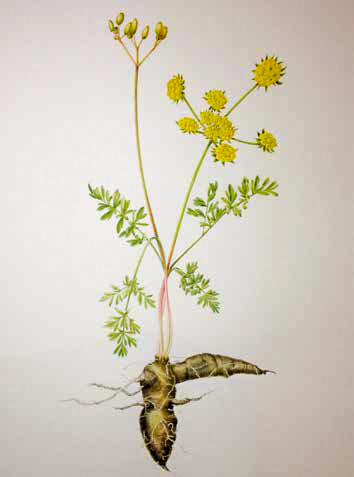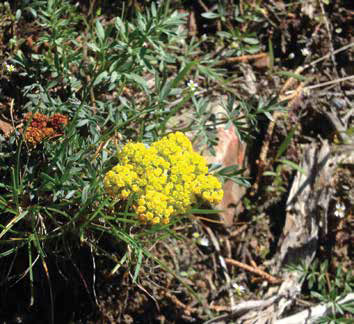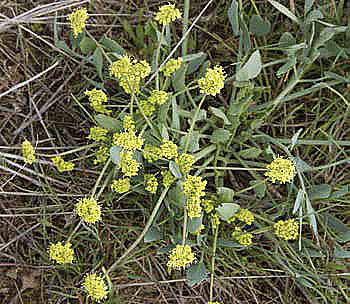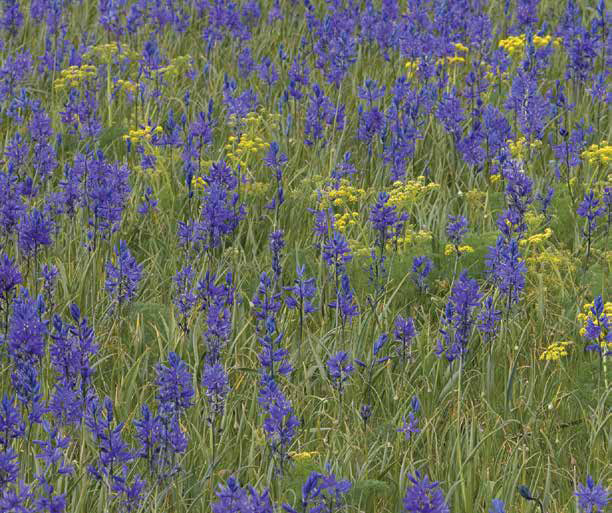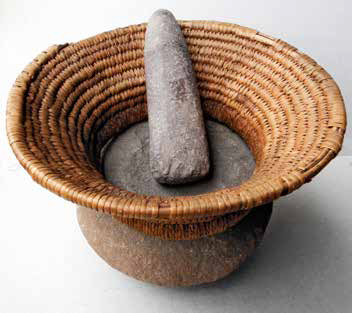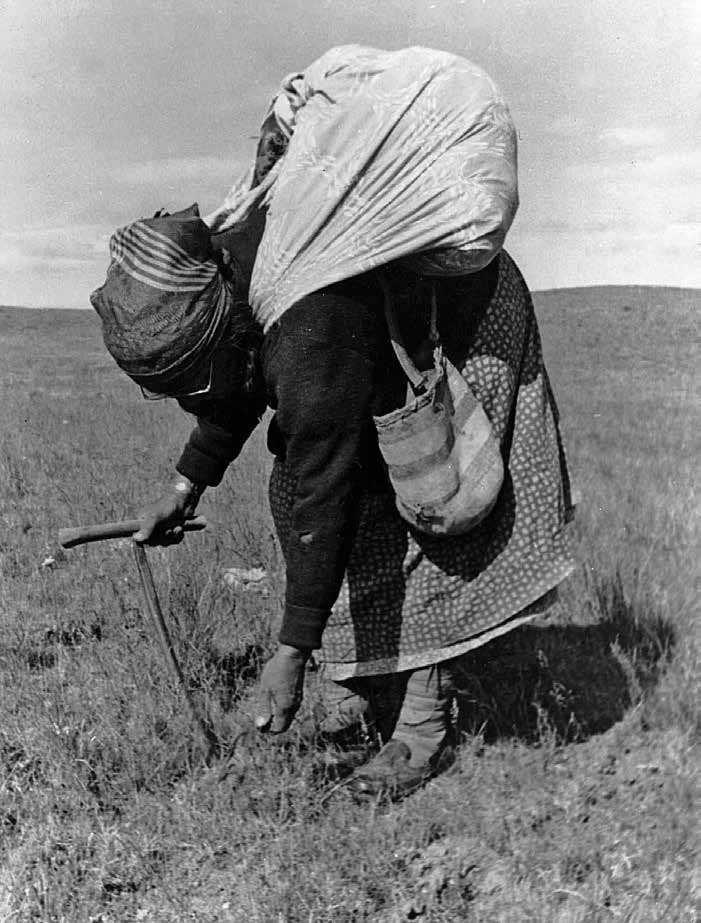The yellow flower of the biscuitroot is scattered amongst bunch grasses and arrowleaf balsam root.
Cous (Lomatium cous) from central Oregon showing the irregularly shaped root.
John B. Leiberg, who carried out plant surveys in the Columbia Basin during the 1890s and was well versed in Meriwether Lewis‘s and William Clark‘s journals, wrote the following observation in one of his letters back to the Smithsonian: “Have you noticed how beautifully these early flowering low umbellifers form a chain from the highest to the lowest elevations in this region?”[2]Leiberg to Rose, 6 April 1894.
Lomatium, a-sáblal, sap-líl
The Columbia Plateau, which encompasses arid regions of Washington, Oregon, and Idaho within the lower Snake and mid-Columbia River drainages, is a great place for spring wildflowers. As early as February, colorful displays begin to creep across the heat-retaining basalt scablands and flood-gravel deposits of the shrub-steppe landscape. Along the well-known track of the Lewis and Clark party through this country, several of the most abundant of these spring blooms belong to the diverse genus locals call biscuitroots or desert parsleys: biscuitroots after a bread-like staple that many western tribes prepare from the roots, and desert parsleys after their habitat and finely-cut leaves. The Latin name for the biscuitroot genus is Lomatium, which means “winged seed” and refers to the severely flattened edges of their ovoid seeds. Several species carry seductive aromas that evoke cultivated relatives such as carrot, parsley, and caraway.
Within the rugged lower Snake and Clearwater River country, traced and retraced by the Corps of Discovery during their journeys west of the Continental Divide, one particular biscuitroot emerges as a clump of dark-green lacy leaves, followed by a single reddish stem that rises no higher than a boot top. The flowers are arranged into compound umbels—small umbrellas of multiple tiny blooms gathered tightly into a larger yellow bumbershoot. The structure supplied the original family name Umbelliferae (also called Apiaceae) and remains the common calling card of the tribe. This yellow biscuitroot, which often forms dense carpets on the ground, is the one known as cous, pronounced both as “coos” and “cows.” Many people—especially members of several Plateau tribes who gather these biscuitroots for food–will quickly praise their flavor, whether boiled, roasted, or pounded and formed into cakes.
The Corps of Discovery had their first taste of cous on 1 November 1805 at the Cascades of the Columbia, near modern Bonneville Dam. Here William Clark watched a broad array of native bands trading robes, skins, beargrass, camas roots, and some flat cakes that he and Lewis called “cha-pel-el” or “shapalell.” It’s not too hard to find corollaries for their spellings in the Chinookan word a-sáblal and the Chinook jargon, sap-líl, both of which translate as “bread.”[3]Gary E. Moulton, ed., The Journals of the Lewis & Clark Expedition 13 vols. (Lincoln: University of Nebraska Press, 1983-2001), 5:371-72.
Cous, xáws
Although the captains described trading for “a kind of biscuit”[4]Ibid., 6:205. during their winter at the mouth of the Columbia, the shapalell did not assume its full importance in their diet until their return journey upstream in 1806. After arriving back at the Cascades of the Columbia in early April, Lewis again noted a lively traffic in goods, with the root bread as one stock item among many. On 12 April 1806 he purchased “2 pieces of Chapellel and Some roots”;[5]Ibid., 7:113. two days later, approaching The Dalles, his grocery list included five dogs, along with hazelnuts, dried berries, and more root bread.[6]Ibid., 7:118.
As the Corps continued upriver, Meriwether Lewis made a connection between shapallell and the abundant yellow flowers he was seeing along the way. His naturalist’s eye recognized them as members of the same family as carrots and dill, familiar from eastern gardens. Near the mouth of the Walla Walla River, he pressed a sample and attached a brief label: “An umbelliferous plant of the root of which the Wallowallas make a kind of bread. The natives call it shappalell.”[7]Frederick Pursh label for collection taken 29 April 1806. He tried to approximate the Sahaptin word for the root, xáws, which he rendered as “cous” and sometimes “cows.”[8]Most tribal languages along this part of the southern Plateau belong to the Sahaptin family. Lewis’s designation was later married to the Latin genus to arrive at the scientific name of Lomatium cous.
On 4 May 1806, while making final preparations for crossing the Continental Divide, the Corps camped on the Clearwater River above its confluence with the Snake, near the village of a hospitable Nez Perce leader called Broken Arm. There they found spring food processing in full swing. “The noise of their women pounding roots reminds me of a nail factory,” Lewis remarked. “The Indians seem well pleased, and I am confident that they are not more so than our men who have their stomachs once more well filled with horsebeef and mush of the bread of cows.”[9]Moulton, Journals,7:239. In other words, the men were getting plenty of horse meat and cous bread to eat. Lewis’s use of the letter “w” instead of “u” in his spelling of cous can sometimes be confusing, but his description of the tuber that was providing so much of the Corps’ sustenance is filled with keenly observed details, some of which must have been supplied by a tribal informant.
Lewis compared cous to the ginseng he had grown up with back in Virginia and the baked camas bulbs that hospitable tribes had fed to the visitors from the moment they arrived in the Columbia drainage. He not only paid close attention to cooking and preservation methods that might benefit the Corps, but also caught a hint of the seasonal rounds involved in collecting and processing the resource.
The cows is a knobbed root of an irregularly rounded form not unlike the Gensang in form and consistence. This root they collect, rub off a thin black rhind which covers it and pounding it expose it in cakes to the sun. these cakes are about an inch and ¼ thick and 6 by 18 in width, when dryed they either eat this brad [bread] alone without any further preperation, or boil it and make a thick muselage; the latter is most comin [common] and much the most agreeable. The flavor of this root is not very unlike the gensang. this root they collect as early as the snows disappear in the spring and continue to collect it until the quawmash [camas] supplys it’s place which happens about the latter end of June.[10]Ibid., 7:234.
As the Corps stockpiled food for its upcoming journey, the great quantities of roots processed with mortar and pestle by Nez Perce women became all the more evident. On 19 May 1806, Lewis noted that a group of his men returned from a trading session with “about 6 bushels of the cows roots and a considerable quantity of bread of the same materials.”[11]Ibid., 7:271-73.
Recalling their difficult mountain journey of the previous fall, the Corps wanted still more. The captains debated sending the crew out to dig on their own but thought better of it. “We would make the men collect these roots themselves but there are several species of hemlock which are so much like the cows that it is difficult to discriminate them from the cows and we are afraid that they might poison themselves,” wrote Lewis.[12]Ibid., 7:275. He was wise to be cautious: parsely family members in that part of the Plateau include not only a host of other Lomatiums and several edible or aromatic relatives but also the extremely toxic western water hemlock, Cicuta douglasii. Plateau plant identification is not an easy learning curve for newcomers.
Choosing to rely on local knowledge, Lewis and Clark issued an allowance of trade goods to the men so they could each purchase “a parsel of roots and bread from the natives as his stores for the rocky mountains.”[13]Ibid. The visitors continued to barter for more cous until early June, when they decided they had enough “bread” to see them through the mountain pass. By then, the Nez Perce women had switched their focus to digging camas bulbs. These the white visitors found less palatable, leading to disappointment with the tribe’s departing gift. “The Broken Arm gave Capt. C. a few dryed Quawmas [camas] roots as a great present,” wrote Lewis on their last day. “In our estimation those of cows are much better, I am confident they are much more healthy.”[14]Ibid., 7:339.
“The natives eat the tops & boil it Sometimes with their Soup . . . the same as we use celery.”
Some varieties of fern-leaf biscuitroot bloom yellow, while others tend toward brown or purple. The latter goes by the name of chocolate tips, and the plant itself was termed “a great horse medicine among the Natives” by Frederick Pursh.
Columbia River Lomatiums
“Cows” was not the only Lomatium the corps collected during their trip upriver that spring, and it was probably not the only biscuitroot that ended up in those shapallel cakes. Sergeant Patrick Gass may have been faintly aware of this diversity when he used the plural to describe “a kind of bread the natives make from roots, and bake in the sun; and which is strong and palatable.”[15]Gary E. Moulton, ed. The Definitive Journals of Lewis and Clark: Patrick Gass (Lincoln: University of Nebraska Press, 1996), 211. Meriwether Lewis may have been on the same track when he referred to “those esculent roots which form a principal part of the subsistence of the natives,” and compared the shape of one tuber, most likely cous, to that of a sweet potato.[16]Moulton, Journals, 7:188. The fact that these plentiful, vigorous, and esculent (which simply means edible) biscuitroots are so diverse, and often so difficult to distinguish from one another, is what defines their larger story.
Several dozen different Lomatium species of the Columbia Plateau have been dealing with the challenging environment of their homeland for a very long time. They have adapted to the short and early growing season, the stiff winds, the cold winters, and the long summer droughts that have long limited vegetation across the region. The compact size of many species enhances their ability to flower very soon after leafing out in the spring. Low growth habits and the lack of a central protruding stem protect the leaves from buffeting winds, and keep them close to a relatively warm layer of air near the ground. Narrow leaf segments, often sliced to minute fineness, provide more surface area for photosynthesis in dry conditions. Their compound umbels, with male and female flowers present on the same plant, allow for both outcrossing and self-pollination by insects or wind.
Smaller Lomatium species quickly complete their reproductive cycles before the rocky soils lose their moisture during the inevitable summer drought. Fruits mature rapidly into winged seeds that dry up and are dispersed by the wind. Finely-cut leaves and stout stems desiccate in a matter of days until they too disappear. Underground, many of these Lomatiums harbor tuberous roots in a wonderful variety of shapes and sizes. These tubers store nutritious carbohydrates during tough winter conditions, then send that essential energy aboveground in the spring to support leaves, flowers, and seed production.[17]Mark A. Schlessman, “Systematics of Tuberous Lomatiums (Umbelliferae),” Systematic Botany Monographs (The American Society of Plant Taxonomists, 1984), 4:16-17.
Although a number of the Columbia River biscuitroots live in habitats created by the great floods that occurred at the end of the last Ice Age, their lifespan has to be measured on an entirely different scale of time. Plant systematists who study Lomatium pollination leap back at least as far as the late Pliocene and visualize changes in millions, not thousands, of years.[18]Schlessman, “Expression of andromonoecy and pollination of tuberous Lomatiums,” Systematic Botany Monographs (The American Society of Plant Taxonomists, 1982) 7:134-49. Geneticists trace plant ranges that flow like amoebas across a landscape, developing new species at their extremities. Cataclysmic events can separate closely related clusters. Some of these colonies might survive in isolation, morph into a slightly different form, then be reunited with their ancestors by more gradual changes in geology or climate. The movements of the Cordilleran glaciers and the spurt of apocalyptic floods that ended the Pleistocene represent only two of the challenges these plants have successfully weathered.
For all their abundance, most of these biscuitroots live so inconspicuously that they have never acquired memorable common names, and the fact that the term “cous” is sometimes applied to several different biscuitroots as a general term only adds to their anonymity. During the time of Frederick Pursh and two other active naturalists who followed in the footsteps of the Corps of Discovery, David Douglas and Thomas Nuttall, species botanists now call Lomatiums were spread across a handful of different genera. In the two centuries that have passed, several closely-allied plants are still classified as outliers, and although taxonomists have devised keys to definitively separate the biscuitroots, words such as “variable” and “overlap” crop up frequently in the text of their technical descriptions. Field researchers not only continue to describe new species, but also consistently manage to find plants that do not fit any prescribed pattern. This is why botanists refer to the genus as “unsettled” and why, at least to a novice, the Lomatium complex seems like a wheeling flock of migrant shorebirds that never quite comes to earth.
A hopper, circa 1800-1870, similar to hoppers used over the thousands of years. The mortar and pestle are of unknown age, probably prior to 1800. They were used by Nez Perce women to pound seeds, roots, etc. Rock is local basalt common to Nez Perce country. The hopper outer diameter is eleven inches.[19]Information courtesy of John W. Fisher.
Traditional Tribal Uses
But some people who live with these plants hold a different kind of vision. Lomatiums have provided a key resource for the Plateau tribes since the end of the last Ice Age, and in the late twentieth century families living around the Yakama Indian Reservation described uses for no less than fourteen different species of biscuitroots.[20]Eugene Hunn, Nch’I-Wana: Mid-Columbia Indians and their Land (Seattle: University of Washington Press, 1990), 99-109. Although the majority were valued for their roots, Lomatium stems, leaves, and seeds all received some mention.
When the Corps of Discovery encountered people gathering food near the mouth of the Klickitat River in April 1806, they paused to collect an herbarium specimen that is clearly barestem biscuitroot (Lomatium nudicaule), for which they noted a tribal use: “The natives eat the tops & boil it Sometimes with their Soup . . . the same as we use celery.”[21]Pursh plant label for collection of 15 April 1806. That comparison of green spring tops with garden celery seems prescient. Today, in the back-and-forth way of cultures sharing place, tribes all over the Plateau call the food that anchors their first spring feasts “Indian celery.” There are several different species that answer to this description, and although barestem biscuitroot remains one of them, it is neither the leaves nor flower umbels that people eat. Women pick the earliest tender shoots before any flowers appear, and serve them with early roots, such as cous.
As noted in two seminal plant books on the expedition,[22]A. Scott Earle and James L. Reveal, Lewis and Clark’s Green World (Helena, Montana: Farcountry Press 2003), 118; Phillips, H. Wayne. Plants of the Lewis and Clark Expedition (Missoula: Mountain … Continue reading of the several other Lomatiums that Lewis and Clark collected, degradation of their pressed specimens makes positive identification impossible today. One likely candidate for a plant Lewis collected on the Clearwater River, and that Frederick Pursh noted as “a great horse medicine among the natives”[23]Pursh label for collection taken 10 June 1806. of the southern Plateau, is fernleaf biscuitroot (Lomatium dissectum).[24]All common and Latin plant names follow current usage on the USDA Plant Profiles web site: http://plants.usda.gov/java/. Accessed 20 November 2015. The huge root of this very robust plant (called “chocolate tips” in areas where the flowers are brownish-purple rather than yellow) is certainly used for medicinal purposes. But in 1826, Scottish naturalist David Douglas described a different aspect of fernleaf biscuitroot in the northern Columbia Plateau, around the mouth of the Okanogan River. Just as the snow was receding, he collected an “Umbelliferae, perennial; flowers purple; one of the strongest of the tribe found in the upper country; the tender shoots are eaten by the natives.”[25]David Douglas, Journal Kept by David Douglas During His Travels in North America (London: William Wesley and Son, 1914), 163. Today, Salishan-speaking Okanagan people from both sides of the international border still gather early shoots of chocolate tips and use them in their first spring feast, calling them “celery.”[26]Nancy J. Turner, et al., Ethnobotany of the Okanagan-Colville Indians of British Columbia and Washington (Victoria: Occasional Papers of the British Columbia Provincial Museum no 21, 1980), 66.
Meanwhile, some Sahaptin-speaking people to the south get their initial dose of spring vitamins from Gray’s biscuitroot (Lomatium grayi), clipping the fresh young stems just as they emerge from the ground. The strong taste of this Indian celery provides a tang clearly distinct from other shoots that share the “celery” name.
For First Feast, Plateau people gather fresh shoots of specific Lomatiums and other plants that form part of their cultural traditions. At the same time, they dig particular early roots and prepare them according to their family ways. Much more than a meal, First Feast is a ceremony renewing a sacred compact, and various Plateau creation stories teach the same lesson in different ways: back in the earliest times, the roots promised to take care of the people, so long as the people promised to take care of the roots.
Two of these Lomatium tubers are clearly the most utilized: Cous (Lomatium cous), the one that appears so often in Meriwether Lewis’s journals, and Canby’s biscuitroot (Lomatium canbyi), which he never mentions. These two biscuitroots are easy to tell apart. The flowers of cous are yellow; those of canbyi are white. Lomatium cous tubers vary wildly in shape, like a wild yam or a brown paper bag blown up and scrunched in every possible way. Those of L. canbyi, on the other hand, swell into perfectly globular spheres that, aside from depressions caused by rocks or other roots, could be mistaken for dark rubber balls.
Cous dominates shrub-steppe habitats in southeastern Washington, Idaho, and eastern Oregon, while the range of Canby’s biscuitroot extends from central Washington along a westward curve that follows the foothills of the Cascade Range south to the Columbia River. When Lewis and Clark entered that region on their return trip upstream in spring 1806, they quickly learned their visit coincided with the season for digging. At Celilo Falls on 17 April 1806, they tried to trade for some packhorses to cross the mountain ranges ahead, but had no luck, because, Clark reported, “The chief informed me that their horses were all in the plains with their womin gathering roots.”[27]Moulton, Journals, 7:134. Plateau families, especially the women and children, were flowing across the countryside, branching and turning and joining again: season-dependent, flexible, persistent, hardy, resourceful, skilled, sharing, and knowledgeable to a degree the white visitors could sense, but in their short time on the scene could never quite grasp.
Gathering Roots
A little further upstream, at the confluence of the Palouse and Snake Rivers, the captains might have seen the ancestors of Mary Jim setting out with twined root bags and digging sticks. In a 1980 oral account, Jim described her family’s travel routes, which had persisted since the early nineteenth century, and for untold generations before that.
“I am a Palouse Indian from the Snake River, where my people have always lived. God put us there, and we prayed, thanking Him for the river and the salmon and all good things,” Mary Jim began. “My father was Alliyua, Thomas Jim, and his father was Fishhook Jim, Chowatyet. We lived at village Tasawiks. My grandmother was Amtaloot, who was from Priest Rapids. Grandmother taught me many things about how to live when I grew up.”
A large part of Mary Jim’s education consisted of learning the rounds for gathering roots—where and when her family sought the wide variety of different biscuitroots and other tubers they needed to sustain them for the coming year.
“We would start to move in March. We would move to Soap Lake, dig certain kinds of roots. They used to dig skúkul [Lomatium canbyi] and some other roots.”
Mary Jim’s family moved all around the central Columbia Plateau, north of the area traveled by the Corps of Discovery. They gained elevation as the season progressed, often arriving on sites at the most favorable moment for Canby’s biscuitroot, but opportunistically digging half a dozen others.
“When we were done there, we moved back to Snake River, last of May maybe, and then salmon came up the river. In the fall, we went over to Walla Walla to dig kouse (Lomatium cous). That’s where we used to camp and dig.
“Then we went up into the mountains to dig other kind of roots. You baked some of them. We traveled a lot. You ought to have seen them horses: packin’, packin’, packin’.”[28]Richard Scheuerman, Palouse Country: Oral History Edition (Colfax, Washington: The McGregor Company, 1994), 52.
Mary Jim’s relatives, who were affiliated with Palouse, Wanapum, Yakama, and other tribal entities, spoke different Sahaptin tongues. Their names for the roots that fed them varied with place, time, growth stage, preparation technique, and taste. Mary Jim learned these names and places from her grandmother and uncle, who had been going to their special sites since they were small children, absorbing the knowledge of generations and passing it along.
For Salishan-speaking tribes in the northern half of the Plateau—central and northeastern Washington, as well as parts the Idaho Panhandle and southeastern British Columbia—the white-flowered Canby’s biscuitroot is more available than its southern cousin, cous. Elders of the Spokane tribe tell a story that explains how these plants came to be distributed across their corner of the Columbia Basin. A character they called “Doodlebug” had just spent a day fishing when he decided to conceal a nice salmon he had speared from his hardworking sister, who had spent her day busily digging roots of several kinds. Upon discovering Doodlebug’s deception, Little Sister was so filled with anger she clambered up a ridge above the Spokane River with all her roots and walked to the edge of the cliff. There, to spite her deceitful brother, she scattered the roots to the four cardinal directions. The roots flew away to new places—including some especially fine p’xúw puxw that landed on Ice Age flood-scoured grounds to the south and west, where people still dig them today.[29]Pauline Flett, s-qwellum’t’: Spokane Legends, trans. by Pauline Flett (Wellpinit, Washington: Spokane Tribe of Indians, 1995), 8-11. The Spokane term for Canby’s biscuitroot is p’xúw puxw, and when native speakers pronounce this word, their mouths and cheeks round out to form perfect globes, just like the roots. Diggers also go after a biscuitroot they call “little p’xw puxw which taxonomists call Lomatium farinosum—a widespread small biscuitroot with flowers of yellow or white depending on where they grow, and a nut-sized spherical root savored by both Sahaptin and Salishan families.[30]Hunn, Nch’I-Wana, 101; Turner, Ethnobotany of the Okanagan-Collville Indians, 68.
Baking Shapallel Bread
On a windy day in early May a couple of years ago, I walked along a stony ridgetop just upstream from the confluence of the Columbia and Snake Rivers with a Sahaptin man who liked plants. He reveled in the bewildering variety of biscuitroots that sprouted within the different rocky exposures, grassy swales, and windblown pockets of loess soil we traversed, calling out names in his language for several of the biscuitroots the corps experienced in 1806. He sampled them all, using a digging stick to turn up everything from round globes of several sizes to the long, skinny carrots of nineleaf biscuitroot, Lomatium triternatum.
Nineleaf biscuitroot is a species that was definitely collected by Lewis along the Clearwater River on 6 May 1806. In his journal the captain noted that the root was “5 or 6 inches long eaten raw or boiled by the natives.” In Frederick Pursh’s additional notes, he termed nineleaf biscuitroot “one of the grateful vegetables of the Indians.”[31]Lewis and Pursh, plant label for Lomatium triternatum.
Although not many tribal families dig this particular species today, Pursh’s comment made sense when I listened to the Sahaptin man describe how he used to watch his mother and aunts dry, bake, roast, grind, and boil different species of biscuitroots in different sequences in order to process them into food. The women would keep all their roots separated until each one was prepared, and then they would combine the array to make small cakes or cookies—a handful of this and a handful of that, shaped into edible form by slapping the palms together. The parents lured their children to join in with the promise they could keep any cookies they made with their own hands. Each handful had a distinctive taste, and each combination went together in a particular way. You learned how to make what you liked. After patting together their cookies, the kids laid them in the sun, then turned them carefully until they were dry enough to store.
One group of neighbors, who gathered cous, Canby’s, and other biscuitroots in many of the same places as the family that made cookies, formed its pounded roots into something more like large pancakes. Each round would be about an inch thick and more than a foot across. The dad would bend together a willow frame, like a small sweat lodge, then build a low, slow-burning fire inside. The family laid its pancakes on top of the frame, so that the fire’s smoke could slowly cure them. Different method. Different taste.
The Sahaptin man arched his fingers to imitate how that red willow frame allowed the smoke to curl around each giant flatbread and seal in all the flavor. He made it easy to picture the men of the Corps of Discovery breathing in that same delicious smell, then trying to barter for one more round of shapallel bread.
Notes
| ↑1 | This article originally appeared in: Jack Nisbet, “One of the Grateful Vegetables: Columbia Plateau Biscuitroots and the Corps of Discovery”, We Proceeded On, February 2016, Volume 42, No. 1. The original article is provided at lewisandclark.org/wpo/pdf/vol42no1.pdf#page=15. |
|---|---|
| ↑2 | Leiberg to Rose, 6 April 1894. |
| ↑3 | Gary E. Moulton, ed., The Journals of the Lewis & Clark Expedition 13 vols. (Lincoln: University of Nebraska Press, 1983-2001), 5:371-72. |
| ↑4 | Ibid., 6:205. |
| ↑5 | Ibid., 7:113. |
| ↑6 | Ibid., 7:118. |
| ↑7 | Frederick Pursh label for collection taken 29 April 1806. |
| ↑8 | Most tribal languages along this part of the southern Plateau belong to the Sahaptin family. |
| ↑9 | Moulton, Journals,7:239. |
| ↑10 | Ibid., 7:234. |
| ↑11 | Ibid., 7:271-73. |
| ↑12 | Ibid., 7:275. |
| ↑13 | Ibid. |
| ↑14 | Ibid., 7:339. |
| ↑15 | Gary E. Moulton, ed. The Definitive Journals of Lewis and Clark: Patrick Gass (Lincoln: University of Nebraska Press, 1996), 211. |
| ↑16 | Moulton, Journals, 7:188. |
| ↑17 | Mark A. Schlessman, “Systematics of Tuberous Lomatiums (Umbelliferae),” Systematic Botany Monographs (The American Society of Plant Taxonomists, 1984), 4:16-17. |
| ↑18 | Schlessman, “Expression of andromonoecy and pollination of tuberous Lomatiums,” Systematic Botany Monographs (The American Society of Plant Taxonomists, 1982) 7:134-49. |
| ↑19 | Information courtesy of John W. Fisher. |
| ↑20 | Eugene Hunn, Nch’I-Wana: Mid-Columbia Indians and their Land (Seattle: University of Washington Press, 1990), 99-109. |
| ↑21 | Pursh plant label for collection of 15 April 1806. |
| ↑22 | A. Scott Earle and James L. Reveal, Lewis and Clark’s Green World (Helena, Montana: Farcountry Press 2003), 118; Phillips, H. Wayne. Plants of the Lewis and Clark Expedition (Missoula: Mountain Press, 2003), 256. |
| ↑23 | Pursh label for collection taken 10 June 1806. |
| ↑24 | All common and Latin plant names follow current usage on the USDA Plant Profiles web site: http://plants.usda.gov/java/. Accessed 20 November 2015. |
| ↑25 | David Douglas, Journal Kept by David Douglas During His Travels in North America (London: William Wesley and Son, 1914), 163. |
| ↑26 | Nancy J. Turner, et al., Ethnobotany of the Okanagan-Colville Indians of British Columbia and Washington (Victoria: Occasional Papers of the British Columbia Provincial Museum no 21, 1980), 66. |
| ↑27 | Moulton, Journals, 7:134. |
| ↑28 | Richard Scheuerman, Palouse Country: Oral History Edition (Colfax, Washington: The McGregor Company, 1994), 52. |
| ↑29 | Pauline Flett, s-qwellum’t’: Spokane Legends, trans. by Pauline Flett (Wellpinit, Washington: Spokane Tribe of Indians, 1995), 8-11. |
| ↑30 | Hunn, Nch’I-Wana, 101; Turner, Ethnobotany of the Okanagan-Collville Indians, 68. |
| ↑31 | Lewis and Pursh, plant label for Lomatium triternatum. |
Experience the Lewis and Clark Trail
The Lewis and Clark Trail Experience—our sister site at lewisandclark.travel—connects the world to people and places on the Lewis and Clark Trail.
Discover More
- The Lewis and Clark Expedition: Day by Day by Gary E. Moulton (University of Nebraska Press, 2018). The story in prose, 14 May 1804–23 September 1806.
- The Lewis and Clark Journals: An American Epic of Discovery (abridged) by Gary E. Moulton (University of Nebraska Press, 2003). Selected journal excerpts, 14 May 1804–23 September 1806.
- The Lewis and Clark Journals. by Gary E. Moulton (University of Nebraska Press, 1983–2001). The complete story in 13 volumes.

